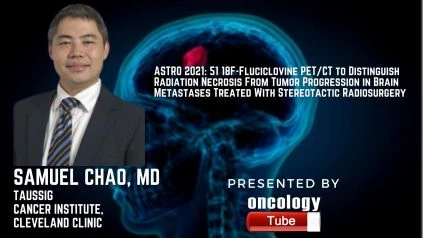Samuel Chao, MD Department of Radiation Oncology, Taussig Cancer Institute, Cleveland Clinic speaks about the ASTRO 2021 Abstract – 51 18F-Fluciclovine PET/CT to Distinguish Radiation Necrosis From Tumor Progression in Brain Metastases Treated With Stereotactic Radiosurgery: Results of a Prospective Pilot Study.
Link to Abstract:
https://plan.core-apps.com/myastroapp2021/abstract/46e4dee0-17bf-49b9-a92f-6097130183e1
Intention:
To present the findings of a prospective pilot study using 18F Fluciclovine PET CT to discriminate radiation necrosis (RN) from tumor progression (TP) in patients with brain metastases (BM) treated with stereotactic radiosurgery (SRS).
Components:
The main goal was to determine how accurate 18F Fluciclovine PET CT was at distinguishing RN from TP. Adults with BM who had SRS and had a follow-up MRI brain (with DSC MR perfusion) that was ambiguous for RN versus TP were included in the study.
Pts had an 18F Fluciclovine PET CT (Siemens mCT) collected 5-15 minutes post-injection with images created by PSF reconstruction within 30 days following equivocal MRI brain. Quantitative measurements for each lesion were recorded, and SUVmean ratios between the lesion and the normal brain were determined.
Clinical follow-up with MRI brain every 2-4 months until a multidisciplinary consensus or tissue confirmation was the gold standard for diagnosing RN versus TP.
Outcomes:
One of the 16 patients enrolled between July 2019 and November 2020 died before being diagnosed, leaving 15 evaluable individuals with 20 lesions. NSCLC was the primary histology in 9 (45%) of the lesions, breast in 7 (35%), melanoma in 3 (15%), and endometrial in 1. (5 percent ). RN was the final diagnosis in 16 (80%) of the lesions, while TP was the final diagnosis in four (20 percent ).
SUVmax (p=0.011) was found to be a statistically significant predictor of TP, with higher SUVmax values indicating TP. The ROC curve’s area under the curve was 0.833. (95 percent CI: 0.590, 1.0). A threshold of 4.3 had a sensitivity of 1.0 (4/4) for identifying TP and a specificity of 0.63 (10/16) for ruling out TP.

